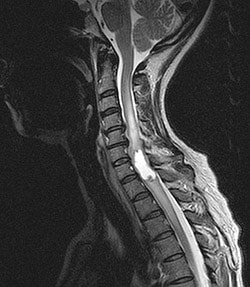Spinal Tumor
A spinal cord tumor (may be either a cancerous or non-cancerous lesion) that grows between the membranes covering the spinal cord or in the spinal canal. A tumor can compress the spinal cord or its nerve roots, so even a non-cancerous growth may be disabling unless it’s properly treated.
The spinal cord contains bundles of nerves that carry messages between the brain and the body. Because the spinal cord is encased in bone, any tumor that grows on or near it can press on the nerves, interfering with this brain-to-body communication. When the tumor presses on the spinal cord, it causes a wide range of symptoms, including :
- ♦ Back pain
- ♦ Severe or burning pain in other parts of the body
- ♦ Numbness or tingling
- ♦ The progressive loss of muscle strength or sensation in the legs or hands
- ♦ Loss of urine or stool control.
A tumor at the top of the spinal column (i.e., cervical region) can cause local neck pain and radiate to the arms or hand; a tumor in the lower spine (i.e., lumbar spine) may cause back pain and radiating pain to the leg; a tumor in the middle (i.e., dorsal spine) can cause local upper back pain and pain radiating around the chest wall region. If there are several tumors in different areas of the spinal cord at the same time, it may cause symptoms in a variety of spots on the body. Suspected spinal cord compression because of a tumor is a medical emergency. Prompt intervention may prevent paralysis. If the tumor is malignant and has spread into the spine from other parts of the body, then treatment depends on the type of cancer it is. Spine Surgery is usually the first step in treating cancerous and noncancerous tumors outside the spinal cord (eg: neurofibroma, meningioma). Tumors inside the spinal cord (eg: astrocytoma, ependymoma) may not be able to completely removed with surgery. If they can’t be removed, radiation and chemotherapy treatments may ease symptoms. Treatment also may include pain relievers and drugs to lessen swelling around the tumor and relieve pressure on the spinal cord.
Early diagnosis and treatment can produce a higher success rate. Long-term survival depends on the tumor’s type, location, and size.
Thus, spinal tumors can occur:
- Inside the spinal cord (intramedullary tumors)
- Between the spinal cord and its covering ‘dura’ (extramedullary – intradural tumors)
- Outside the dura (extradural tumors)
Or, tumors may extend from other locations. Most spinal tumors are extradural. Many bony tumors are described which involve spine bone primarily and can pinch the spinal cord later.

